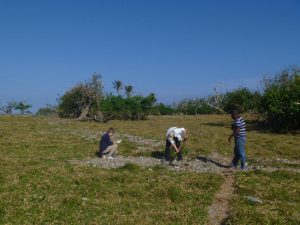22 December 2016
Humidity may cloud sediment deposits used to study storms
Posted by Lauren Lipuma

Researchers collect samples of pumice storm deposits on Efate Island, Vanuatu. A new study finds using sediment as an indicator of past hurricanes may not work well in hot, humid environments.
Credit: Isabel Hong.
By Sarah Derouin
Using sediment as an indicator of past hurricanes may not work well in hot, humid environments, a new study finds. The finding could change the way scientists hunt for evidence of past storms, according to the study’s authors.
Tropical cyclone Pam pummeled the south Pacific in 2015 with winds up to 270 kilometers per hour (170 miles per hour). The category 5 storm’s intense winds broke weather instruments, making it difficult for scientists to study the storm.
In the absence of weather instruments, scientists use storm deposits to infer the type and intensity of past storms. In intense storm systems, strong winds can move large grains of sediment. As the wind dies down, the size of the transported grains also gets smaller.
Now, a new study shows using sediment deposits to study past storms may not work in hot, humid environments like the area where Pam made landfall. Complementary methods such as using phytoplankton to reconstruct past records of water temperature, depth and salinity could give a more accurate history of cyclones in the region, according to the study’s authors.
Humid environments cause rock weathering, which makes it difficult to distinguish between different types of sediment, said Isabel Hong, a coastal geologist at Rutgers University in New Jersey.
“We hypothesize that in these tropical environments, it’s so humid that to a certain extent, the sediment is homogeneous,” said Hong, who presented the new findings Wednesday at the 2016 American Geophysical Union Fall Meeting in San Francisco.

Showing school children sediment from a soil pit on Tanna at Port Resolution Bay.
Credit: Isabel Hong.
To study Pam and its aftermath, scientists converged on Vanuatu, a group of islands wedged between Fiji and New Zealand.
They sampled a deposit of pumice left by Pam on top of a grass field. The scientists dug pits in the deposit, extending from the shoreline to 100 to 150 meters (330 to 500 feet) on land, to see how deposits might change.
Surprisingly, even though cyclones have enough power to move large grains of sediment, the team found no discernable change in sediment size between the sediment transported by Pam far up on land and deposits underneath.
Given the humidity on Vanuatu, where Pam made landfall, weathering has progressed to a point of producing homogeneous sediment, Hong said.
Examining the deposit from Pam allowed the team to infer what past storm deposits might look like under the ground. The findings suggest in some tropical environments, using only grain size to hunt for past storm deposits might not be the best approach.
Using multiple proxies could give a more accurate history of cyclones in the region, Hong said. For example, foraminifera are tiny organisms that mostly live in water; specific species prefer certain kinds of water, making them great indicators of past water temperature, water depth or salinity. There are different species of foraminifera that occur naturally in beach sediments while other species are brought in by storm surges. Preliminary work identifying these microscopic creatures within Vanuatu sediment looks promising for reconstructing storm histories on the island, according to Hong.
—Sarah Derouin is a science communication graduate student at UC Santa Cruz. You can follow her on twitter at @Sarah_Derouin.










 GeoSpace is a blog on Earth and space science, managed by AGU’s Public Information staff. The blog features posts by AGU writers and guest contributors on all sorts of relevant science topics, but with a focus on new research and geo and space sciences-related stories that are currently in the news.
GeoSpace is a blog on Earth and space science, managed by AGU’s Public Information staff. The blog features posts by AGU writers and guest contributors on all sorts of relevant science topics, but with a focus on new research and geo and space sciences-related stories that are currently in the news.